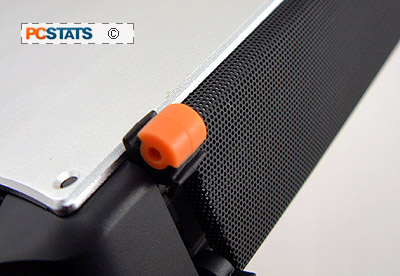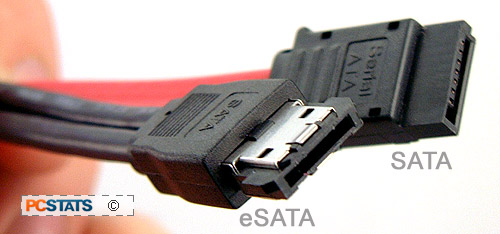 The SATA hard drive installs in the aluminum
caddy and is connected with a standard hot swappable SATA data jack fixed
to the rear. A few screws (included) ensure the hard drive stays put,
and that the HDD chassis makes direct contact with the aluminum for small
measure of conductive cooling. With the lid back in place. The key lock on the
front of the Icy Dock external chassis is what makes the entire system
work.
The SATA hard drive installs in the aluminum
caddy and is connected with a standard hot swappable SATA data jack fixed
to the rear. A few screws (included) ensure the hard drive stays put,
and that the HDD chassis makes direct contact with the aluminum for small
measure of conductive cooling. With the lid back in place. The key lock on the
front of the Icy Dock external chassis is what makes the entire system
work.
The drive caddy must be locked in place inside the external chassis for power
to flow to the hard drive, and the caddy must be unlocked to be hot swappable -
it's the perfect definition of counter productive. Loss of the little key is not
incredibly important, the lock is of such poor quality that any key from any
such similar HDD rack will work.
So long as you are running Windows XP or Vista, and the removable hard drive caddy does not contain
your operating system, the PC will react pretty sensibly to the immediate removal
or insertion of a hard drive. It's best practice to go to "removable devices"
in the control panel and "stop" the hard drive before pulling it out
of a running computer, or data loss may occur. This step ensures data integrity
while the latter is a little like playing russian roulette with your data.
SATA is inherently hot swappable so it won't affect the drive.
The general build quality of the Icy Dock MB452 is nice,
we particularly like the little rubber feet which help reduce vibrations and noise
for high speed drives. The aluminum parts of the chassis have been sand blasted
and anodized, so this should allow them to hold up to little bumps
and scrapes well enough.
eSATA Device Support
 eSATAII (aka external Serial ATA) support is easily
the most exciting feature to pop on motherboards of recent. When it comes to
external mass storage, bandwidth has always been, and will always be an issue.
USB 2.0 (480 Mbps) and IEEE 1394a/b (400/800 Mbps) offer better alternatives
than past connections like Serial and Parallel ports but they are still slow
compared to dedicated hard drive channels.
eSATAII (aka external Serial ATA) support is easily
the most exciting feature to pop on motherboards of recent. When it comes to
external mass storage, bandwidth has always been, and will always be an issue.
USB 2.0 (480 Mbps) and IEEE 1394a/b (400/800 Mbps) offer better alternatives
than past connections like Serial and Parallel ports but they are still slow
compared to dedicated hard drive channels.
With the emergence of Serial ATA, external storage
took a huge step forward. Serial ATA is an affordable solution (as opposed to
SCSI) that offers speeds at well past USB or IEEE 1394 levels. Serial ATA
generation I has up to 1.5Gbps worth of bandwidth and Serial ATA generation II
doubles that bandwidth to 3Gbps. Serial ATA makes even IEEE 1394b's 800Mbps
bandwidth look paltry by comparison.
Standard
internal Serial ATA cables are sufficient for internal connections,
but SATA-IO governing body decided a while back
that the external version should be somewhat different, thus creating the
eSATA standard. The eSATA cable that accompanies the Icy Dock MB452 is
the eSATA I ('eye' not 'one') type connector (of the
two pictured, it is the left one). There are also eSATA L
connectors floating around, so we'd advise you to double check what type of connector end
is on any kind of cables you might pick up.
The
great thing about eSATA enclosures is that hard drives connected over this standard are just
as fast as internal SATA devices. The connectors are hot swappable, so
it makes adding and removing an external hard drive about as complex as clipping
in a USB memory key.
